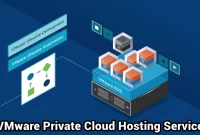
Get to know IBM Virtual Private Cloud Services
IBM Virtual Private Cloud (VPC) is a robust cloud computing service offered by IBM that provides users with a secure and scalable network environment for deploying their applications and resources. IBM VPC enables organizations to create their own isolated virtual networks within the IBM Cloud infrastructure, offering enhanced control, privacy, and flexibility. With IBM VPC, users can define their IP address ranges, subnets, and network configurations, allowing for customized network architectures. The service provides a high level of network isolation, ensuring that resources and data are protected from unauthorized access. Organizations can implement granular security controls and network policies to enforce strict access rules and protect sensitive information.

One of the key benefits of IBM VPC is its seamless integration with other IBM Cloud services. Users can leverage a wide range of services, such as IBM Cloud Object Storage, IBM Watson AI services, and IBM Cloud Databases, within their VPC environment. This integration enables organizations to build comprehensive cloud solutions that leverage the power of various IBM Cloud services while maintaining the security and control provided by the VPC. IBM Virtual Private Cloud (VPC) offers organizations a secure and customizable network environment within the IBM Cloud infrastructure. With its robust features, network isolation, integration with other IBM Cloud services, and scalability, IBM VPC provides a solid foundation for deploying applications, managing resources, and achieving the desired levels of control and security in the cloud.
About IBM Virtual Private Cloud Service
IBM Virtual Private Cloud (VPC) Service is a cloud computing solution provided by IBM that allows organizations to create and manage their own virtual network environments within the IBM Cloud infrastructure. It provides a secure and isolated space where users can deploy their applications and services while maintaining control over their network configuration. IBM VPC Service offers a range of features to support the creation and management of virtual networks. Users have the flexibility to define their own IP address ranges, create subnets, and configure network gateways and routing tables. This allows for customized network architectures that align with specific business requirements.
One of the key advantages of IBM VPC Service is its focus on security. It provides network isolation to ensure that each organization’s resources are separated and protected from other users in the cloud. Users can implement security controls, define access rules, and utilize encryption to safeguard their data and applications. Furthermore, IBM VPC Service integrates seamlessly with other IBM Cloud services, allowing users to take advantage of a comprehensive ecosystem. This enables organizations to leverage additional services such as storage, AI, analytics, and databases within their VPC environment, enhancing the capabilities of their applications and workflows.
IBM Virtual Private Cloud (VPC) offers a range of features and benefits that empower organizations to build and manage their cloud infrastructure in a secure and customizable manner. Here are some key features and benefits of IBM VPC:
- Network Isolation and Control: IBM VPC provides network isolation, allowing organizations to create their own dedicated virtual network environment within the IBM Cloud. This ensures that their resources and data are separate from other users, providing enhanced security and privacy. Users have granular control over network configurations, including IP address ranges, subnets, routing tables, and security policies.
- Security and Compliance: IBM VPC prioritizes security and compliance by providing robust security features and tools. Users can implement security controls such as network security groups, firewall rules, and encryption to protect their data and applications. IBM VPC also supports compliance with industry regulations and standards, enabling organizations to meet their specific security and governance requirements.
- Scalability and Flexibility: IBM VPC offers scalability and flexibility, allowing organizations to scale their resources up or down based on demand. Users can add or remove virtual servers, storage, and network components easily, enabling them to optimize resource allocation and cost efficiency. IBM VPC also provides options for load balancing and auto-scaling to handle varying workloads effectively.
- Integration with IBM Cloud Services: IBM VPC seamlessly integrates with other IBM Cloud services, providing access to a wide range of additional capabilities. This includes services like IBM Cloud Object Storage, AI-powered services like IBM Watson, and databases such as IBM Db2. Integration with these services allows organizations to enhance the functionality and value of their applications within the VPC.
- Hybrid Cloud Connectivity: IBM VPC supports secure connectivity options for seamless integration with on-premises infrastructure. Users can establish Virtual Private Network (VPN) connections, utilize dedicated network connections like IBM Direct Link, or leverage IBM Cloud Satellite to extend their VPC to edge locations. This enables organizations to create hybrid cloud environments that combine the benefits of both cloud and on-premises infrastructure.
IBM Virtual Private Cloud (VPC) offers features and benefits that enable organizations to create a secure, scalable, and flexible network environment within the IBM Cloud. With network isolation, robust security measures, seamless integration with other IBM Cloud services, and options for hybrid cloud connectivity, IBM VPC provides organizations with the tools and capabilities they need to build and manage their cloud infrastructure effectively.
IBM VPC Plans and Pricing
IBM Cloud® Virtual Private Cloud (VPC) offers a variety of plans and pricing options to meet the needs of different organizations.
Pay-as-you-go
The pay-as-you-go plan is the most flexible option and allows you to use the resources you need when you need them. You are charged for the number of virtual CPUs (vCPUs), the amount of memory, and the amount of storage that you use.
Reserved capacity
The reserved capacity plan gives you a discount on the cost of compute, storage, and network resources if you commit to using a certain amount of capacity for a certain period of time.
Bring your own license (BYOL)
The BYOL plan allows you to use your own software licenses on IBM Cloud VPC. This can save you money on the cost of software licenses.
Hybrid cloud
The hybrid cloud plan allows you to connect your on-premises environment to IBM Cloud VPC. This can help you to save money on the cost of infrastructure and to improve the performance of your applications.
Pricing
The prices for IBM Cloud VPC vary depending on the region, the size of your resources, and the plan that you choose. You can find more information about IBM Cloud VPC pricing on the IBM website.
Here are some examples of IBM Cloud VPC pricing:
- Pay-as-you-go: For a 1 vCPU instance with 2 GB of memory and 10 GB of storage, the hourly price is $0.045.
- Reserved capacity: For a 1 vCPU instance with 2 GB of memory and 10 GB of storage, the monthly price is $30.
- BYOL: The BYOL price for a 1 vCPU instance with 2 GB of memory and 10 GB of storage is $20.
- Hybrid cloud: The hybrid cloud price for a 1 vCPU instance with 2 GB of memory and 10 GB of storage is $15.
Here are some tips for reducing the cost of IBM Cloud VPC:
- Use the right number of vCPUs and memory. If you use too many vCPUs and memory, you’ll be charged more than you need to be.
- Use the right amount of storage. If you use too much storage, you’ll be charged more than you need to be.
- Use data transfer optimization. IBM Cloud offers data transfer optimization, which can help you reduce the amount of data transfer charges you incur.
- Use reserved capacity. IBM offers reserved capacity discounts for IBM Cloud VPC. If you commit to using a certain amount of capacity for a certain period of time, you can save money.
- Use a managed service. There are a number of managed services that can help you to reduce the cost of IBM Cloud VPC. These services can handle the provisioning, management, and monitoring of your IBM Cloud VPC infrastructure, so you can focus on your data.
- Use a hybrid cloud approach. If you have some workloads that can be run on-premises and some that can be run in the cloud, you can use a hybrid cloud approach to save money. You can run your on-premises workloads on your own hardware and run your cloud workloads on IBM Cloud.
- Use a community cloud. If you are part of a community, you can use a community cloud to save money. A community cloud is a shared cloud that is owned and operated by a community of organizations. You can use the community cloud to run your workloads and save money on the cost of infrastructure.
How to use IBM Virtual Private Cloud
To use IBM Virtual Private Cloud (VPC), follow these steps:
- Create a VPC: Start by creating your virtual private cloud within the IBM Cloud platform. Specify the desired configuration, such as the IP address range and subnet settings, and set up the basic network structure for your VPC.
- Define Subnets: Within your VPC, define subnets based on your network requirements. Subnets allow you to segment your VPC into smaller networks for better organization and resource allocation. Assign IP address ranges to each subnet and configure their connectivity options.
- Set Up Security: Implement security measures to protect your VPC resources. Define security groups to control inbound and outbound traffic and apply firewall rules to restrict access. Consider utilizing network access controls, encryption, and other security features to enhance the protection of your data and applications.
- Deploy Resources: Once your VPC is set up, deploy your desired resources within the VPC. This can include virtual servers, storage instances, load balancers, databases, and other services offered by IBM Cloud. Ensure that you assign these resources to the appropriate subnets and configure their connectivity and security settings accordingly.
- Configure Connectivity: Establish connectivity options to connect your VPC to external networks or on-premises infrastructure. IBM VPC supports Virtual Private Network (VPN) connections, dedicated network connections like IBM Direct Link, and hybrid cloud solutions with IBM Cloud Satellite. Configure the appropriate connectivity option based on your requirements for seamless integration and data transfer.
- Manage and Monitor: Regularly monitor and manage your VPC to ensure optimal performance and security. Utilize monitoring tools and analytics provided by IBM Cloud to gain insights into network traffic, resource utilization, and potential issues. Adjust your configurations as needed, scale resources, and apply updates or patches to maintain the health and efficiency of your VPC.
Remember to refer to the official IBM Cloud documentation and resources for detailed instructions on using IBM Virtual Private Cloud.








